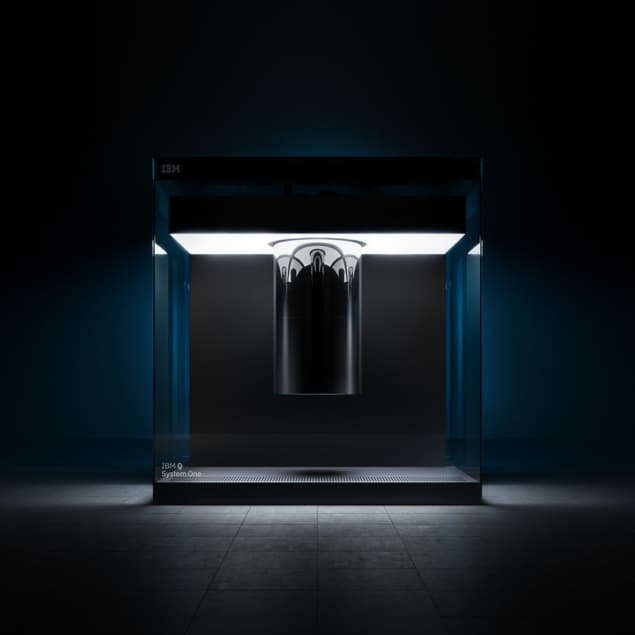Time crystals on a quantum computer reach record size
11 Mar 2022

Researchers in Australia have created the largest time crystal to date, using 57 qubits on an openly accessible IBM quantum computer to construct an exotic phase of matter with properties that repeat over time, rather than in space. The result emphasizes the utility of quantum computers for simulating complex quantum systems, and marks an important step towards creating even larger systems of time crystals.
The idea of using quantum computers to study quantum effects first rose to prominence in 1982, when the physicist Richard Feynman postulated that “to simulate quantum systems you would need to build quantum computers”. In the latest work, physicists Stephan Rachel and Philipp Frey of the University of Melbourne applied this principle to an intriguing type of quantum system known as a discrete time crystal (DTC). Whereas normal, material crystals display a fixed-dimensional periodicity in their structure, DTCs repeat their properties in time, with cycles that have an integer multiple of the period of the force that causes the change.
In principle, DTCs can do this forever without being destroyed by thermal effects – something that might, at first, appear to violate the second law of thermodynamics. However, unlike normal systems, DTCs do not thermalize because, thanks to a phenomenon known as many-body localization (MBL), they do not absorb energy. Achieving MBL requires a certain amount of disorder and interactions between multiple quantum objects, such that different quantum states exchange energy and never reach equilibrium.
To classify as a DTC, a system also needs to be truly many-body, and its coherence times (that is, the time over which fragile quantum states persist without being destroyed by interactions with their environment) must be long enough that its periodic variations are not mistaken for a short-term system change. Finally, one must be able to prepare the system in arbitrary initial states and show that all of them result in similar DTC behaviour.
A major milestone
The Melbourne team’s work, which is described in Science Advances, builds on earlier reports of DTCs that used quantum processors based on nine nuclear spins in diamond and 20 superconducting qubits. As in these previous experiments, the team turned a quantum computer into an experimental platform – a quantum simulator – in which all the requirements of DTCs could be met.
The DTC this time is made up of a chain of 57 quantum bits, or qubits. Its periodic change is due to randomized (disordered) flipping of qubits over the entire chain, with an imperfect spin-flip as the initiator and driving force, while the couplings between the qubits in the chain create the required many-body interactions. The researchers showed that this system fulfilled the requirements of a DTC over 50 cycles, with the duration mainly limited by the error rate of the quantum computer. Importantly, the team created DTCs from a wide range of initial parameters, made possible by the large number of qubits involved. When the researchers changed the parameters to values for which no DTC was expected, the quantum system quickly collapsed, making it possible to distinguish DTCs from non-DTCs in an experimentally accessible number of periods.
The noise still annoys
According to Rachel, the main limitation in their research was the experimental noise. Like all of today’s quantum computers, the IBM machine they used is a noisy intermediate scale quantum (NISQ) device, one that lacks an error mitigation scheme that would help separate the effects of noise from the system’s internal thermalization processes. Nevertheless, Rachel says it is exciting to have such prototype quantum devices openly available. The fact that this work was done by a team of just two researchers is, he adds, evidence of the strength of the IBM platform.READ MORE

Tim Taminau, a researcher at QuTech in the Netherlands who was not involved in the study, calls the Melbourne team’s work “an important contribution to the field”. In his view, the experiment “ticks all the boxes for creating a DTC” and the results are “consistent with DTC behaviour”. However, while the large number of qubits involved is, he says, “extremely impressive”, it is notable that the DTC’s lifetime is limited by decoherence, rather than by the size of the system. “Even for small systems with ~10 qubits the DTC response is theoretically predicted to last over a million periods before finite-size effects become visible,” he tells Physics World. “Therefore, an important challenge remains to further improve the qubit quality.”
Martijn Boerkamp is a science journalist based in the Netherlands
from physicsworld.com 7/4/2022
Δεν υπάρχουν σχόλια:
Δημοσίευση σχολίου